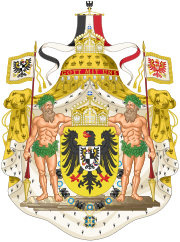| Prince Joachim Albert | |||||
|---|---|---|---|---|---|
| Prince of Prussia | |||||
 Prince Joachim Albrecht, May 1928 Castle Kamenz | |||||
| Born | 27 September 1876 Hanover | ||||
| Died | 24 October 1939 (aged 63) | ||||
| Spouse | Marie von Blich-Sulzer Karoline Kornelia Stockhammer | ||||
| |||||
| House | House of Hohenzollern | ||||
| Father | Prince Albert of Prussia | ||||
| Mother | Princess Marie of Saxe-Altenburg | ||||
| Prussian Royalty |
| House of Hohenzollern |
|---|
 |
| Descendants of Frederick William III |
Prince Joachim of Prussia (27 September 1876 – 24 October 1939) was a member of the House of Hohenzollern. He was the second eldest son of Prince Albert of Prussia and his wife Princess Marie of Saxe-Altenburg. He is notable for composing music, in particular military waltzes.[1]
YouTube Encyclopedic
-
1/5Views:1 6881 1851 4173071 001 481
-
The Isted Lion: Returning disputed heritage
-
Prussia
-
Napoleonic Wars
-
State of the Teutonic Order
-
Flute Fundamentals [HD]
Transcription
Family and early life
Prince Joachim's paternal grandparents were Prince Albert of Prussia and Princess Marianne of the Netherlands. His maternal grandparents were Ernst I, Duke of Saxe-Altenburg and Agnes of Anhalt-Dessau.
Joachim had two brothers: Friedrich Heinrich Albrecht (1874–1940) and Friedrich Wilhelm (1880–1925).
In 1885, Joachim's father Prince Albert was chosen as regent for the Duchy of Brunswick. Like all male Hohenzollerns, Joachim and his brothers entered the army and became officers. Music always appealed to him however, and he soon made a name for himself composing. In 1898, he presented a military waltz he wrote to a family gathering at the Neues Palais in Potsdam.[1] An orchestra played it, while Emperor Wilhelm conducted it with his baton. In 1905, he wrote the libretto and pantomime for "The Apple of Paris", which was well received in Berlin.[2] He also composed ballets and symphonies, and wrote a volume of poetry and painted. During World War I, Joachim served with distinction until he received a war wound.[2] This wound effectively ended his military career and allowed him to completely focus on his music.
Marriages
On 3 September 1909, Joachim married Marie Blich-Sulzer, divorced Baroness of Liebenberg, in Ischl, Austria. The marriage was never recognized by the family, and he had many public clashes with ex-Emperor Wilhelm. According to some sources, a previous marriage had led to Wilhelm banishing him by stationing him with the German colonial army in Africa; it is also believed that his resignation was demanded. His inheritance was also dramatically reduced.[2] He married secondly to Karoline Kornelia Stockhammer on 9 October 1920 in Vienna. He and Karoline divorced in 1936.
Joachim died three years later, on 24 October 1939.
Music
Like many of his family, Prince Joachim had a great love of music. Unlike the rest of them however, he spent his whole life playing and performing in different cities around the world. He also was an accomplished violin and cello player. He described himself as old-fashioned, especially in relation to music. He stated in 1927 that he was old-fashioned "because I am a thoroughly healthy individual. Much modern music is unnatural and discordant because composers and audiences have jaded nerves which need stirring up. I want my hearers to leave my concerts with the feeling that I have furnished them with esthetic [sic] delight and instilled harmony and beauty into their souls".[2][3]
In 1920, Joachim was ordered under arrest by the German Minister of Defense Gustav Noske after he got into a fight with some French military officers.[4] The dispute apparently began after a few of the aforementioned officers failed to stand up when musicians in a nightclub began to play the national anthem "Deutschland Uber Alles". The fight soon escalated, so that many bystanders joined in to defend both sides. Although he later denied his actions, enough scorn emerged against him among most of Europe's newspapers to merit the event's impact on his reputation.[4]
In 1926, Joachim accepted an invitation to present his compositions in a series of concerts in leading American cities.[5] He received this invite after playing in a number of welfare concerts in Berlin, and conducting his own works throughout the previous summer in Central Germany.[5] One such concert was planned for Newark, in which Joachim would be conducting an orchestra to music written by himself.[6] All of these concerts would have been done for various charitable organizations. After his arrival in the United States however, it soon emerged that he would do no performing while in the country.[7]
Ancestry
References
- ^ a b "Without Prejuduce" (PDF), The New York Times, Berlin, 16 January 1898
- ^ a b c d "Kaiser's Cousin Now Here", The New York Times, New York, 18 March 1928
- ^ Love, Sam (1928-03-07). "Ex-Kaiser's Cousin Totes Battered 'Cello Into N.Y." The Morning Post. p. 2. Retrieved 2020-11-07.
- ^ a b "Ex-Kaiser's Cousin Put Under Arrest", The New York Times, Berlin, 8 March 1920
- ^ a b "Prince to Lead Music Here", The New York Times, Berlin, 27 October 1926
- ^ "Prince Joachim Plans a Concert in Newark", The New York Times, New York, 12 March 1928
- ^ "Joachim Not to Wave Baton in America", The New York Times, Philadelphia, 16 March 1928
External links
- Free scores by Prince Joachim Albert of Prussia at the International Music Score Library Project (IMSLP)
